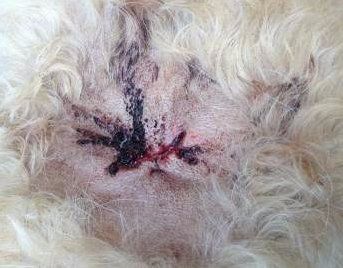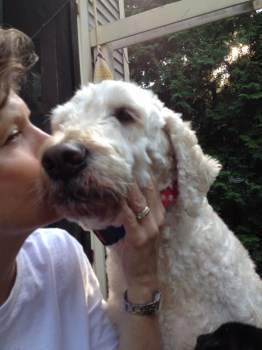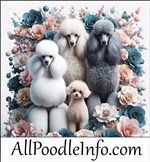Poodles and Ingrown Hairs
Overview
Ingrown hairs are not an uncommon problem with the Poodle breed and while this can resolve on its own and many times an ingrown hair can remain on a dog for a long period of time without any issues, with other Poodles, it can develop into a much more serious issue.
For this reason, we are answering a Member's question about ingrown hairs in detail on this site, so that you will know how to handle this should it happen to your Poodle, along with treatment options. Importantly, we will also go over several methods of preventing this from happening.
Question:
Hi, My Name is Julie and I have a standard Poodle (Clancy) I rescued about 8 years ago.
He had eaten an entire bag of fertilizer and was very ill at the breeders, so she basically gave him to us. He has had many, many health issues over the years but the latest one I am hopeful you can give me some advice about. He had what appears to be an ingrown or irritated hair follicle that would not heal.
My vet said this does happen to Poodles more frequently than other breeds. He appears to have two other small spots starting. I finally had to have it cut out, leaving him with a large painful incision and a vet bill to match.
Are there any preventative measures I can take either with bathing, grooming or diet that you can suggest? I do have him professionally groomed and kept short in the summer, and a little longer in the winter. I do also bathe him at home about every three to four weeks in between grooming sessions.
Thank you for any suggestions you can make. Sincerely, Clancy and Julie
Please note:
AllPoodleInfo is reader-supported, and some of the product suggestions on this page are affiliate links. As an Amazon Associate we earn from qualifying purchases. This is at no extra cost to you and helps us continue providing free, high-quality information.
Answer:
Hi Julie,
We're sorry to hear about this... it's amazing how much pain (and money spent) can be the result from something as innocent sounding as a hair follicle! This is a bit more common with Poodles than with other breeds due to the Poodle's naturally curly hair.
Why this happens:
A hair can become ingrown if the pore is clogged (via dead skin, grooming products, minuscule debris or a combination of all of these) and then the hair that is inside of that pore may grow sideways under the skin or the top of the hair strand can curl back around and pierce the skin, continuing on to grow down into the body instead of up and out. Since the Poodle has curly hairs (each hair is already coiled and primed to grow inverted if there is any obstruction), this can happen more easily than other breeds with straight hair.
While many ingrown hairs will simply resolve on their own (if they are not too deep), some will present problems as you described.
There are several things that you can do to try and prevent this:
1)
Keep the coat as short as possible but do not shave the coat.
Shaved coats are a leading cause of ingrown hairs, however Poodles with short coats do have less problems with this than those with longer coats. Therefore a close (by not shaved) clip will prevent this to some degree.
We understand your inclination to want to keep it a bit longer in the winter for warmth, however a few cute, warm sweaters and such will keep your Poodle cozy and happy. It's common for a Poodle to need a bit of help during cold weather (and this is particularly true of Toy Poodles.) You'll find that a lined vest or soft sweater will help your dog stay outside for walks and be more comfortable with the harsher outdoor conditions that many of us experience during the wintertime.
2) Brush your Poodle every day.
The goal will be to keep the skin healthy via using deep strokes that massage the skin over the entire body. This will aide in proper distribution of body oil and remove flakes of dead skin which naturally develop on a constant basis, all day, every day.
Remember that the next potential inverted hair follicle may pop up on a completely different part of the body, so you will want to go over the entire body... head, neck, ear base, chest, shoulders, back, legs, even the tail.
Long, deep strokes are best. Since over-brushing can cause some dryness to the hair, you can use a light misting spritz which is good for both skin and coat (more ahead). An appropriately sized pin brush or slicker brush will work just fine.
3) Use super high quality grooming products.
The shampoo, conditioner (or finishing creme) and leave-in coat protection products that you use will not just affect the health of a Poodle's hair, the right products will also go a long way in keeping the skin healthy, which does help prevent ingrown hair follicles to some degree.
It's important for shampoo
to do its job to clean away tiny dead skin particles (which can be a cause of inverted hairs) yet must be gentle enough and have the right PH balance to not dry out the skin. Using the right conditioner is important because you want a good one that properly coats the hairs to protect them, keeps the hair super soft and healthy... but not so heavy that it clogs skin pores... And the leave-in spritz should protect the coat from sun damage and contact friction while moisturizing the skin.
4) The timing of baths is important.
Over-bathing can cause this to some extent, due to the issue of dry skin that can develop from having baths too frequently. Dry skin results in tiny skin flakes that can disrupt the hair follicle's direction of growth. Even with superior bathing products, removing naturally occurring body oil too often can dry the skin. Opposite to this, not bathing enough can cause a buildup of tiny debris and accumulation of oil that causes the pores to clog and then, in turn, an inverted hair. Keeping your Poodle on a strict schedule of having a bath
every 3 weeks will help.
5) Keep an eye out for ingrown hair follicles
as they are beginning to develop...Many times, a hair can become ingrown and will not a cause a problem... If the hair is just under the first layer of skin, many times it can be removed via a tweezers or easily lanced out by the veterinarian quite easily.
Some Poodles develop one at a time and others may have a small cluster or several affected follicles spread out over different areas of the body. If you spot one, do not assume that it is the only one.
If you are able to detect an ingrown hair at this early stage, you may be able to have it dealt with early and for less money than what will happen if it grows deeper. Though it should be noted that the coat (even if short) will prevent immediate detection in many cases and it's not uncommon for the area to be undetectable until it is raised and/or festering from bacteria.
Issues will arise, as you know, if the area becomes infected or if the hair is deeper than that one layer. If a Poodle has an issue with clusters of ingrown hairs, this is often referred to as Folliculitis, which is essentially inflamed hair follicles. In some cases, a minor issue that could have been resolved more easily, will escalate into Folliculitis, with Staphylococcus pseudintermedius being the most common form of infection. Fungal infection is also possible.
Some inverted hairs are just very stubborn and while a vet may suggest a 'wait and see' approach if the skin looks healthy, these can gradually worsens until surgical intervention is the only course of action. So, again, you'll want to inspect your Poodle on a regular basis, and this is much easier to do if the coat is keep short, as recommended.
Also, early signs of infection are if a Poodle starts chewing
on a particle area. When you look at the area, you may see a small red bump or a bump that appears to be filled with pus. These can be very tiny (smaller than the size of a pencil eraser) or if there are several affected follicles in a clump, this may appear to be the size of a dime or even a nickel.
Once it becomes severe, too bothersome for the dog or is infected, there will need to be surgical intervention.
There are a couple of more prevention tips... However, while you are, of course, familiar with this, let's cover the treatment options, should it reach this phase:
Treatment for minor cases, if there is any intervention at all, involves a simple procedure to remove the ingrown hair(s). If it involves just 1 or 2 layers of skin and there are no signs of infection, it may be able to be removed by the vet with a tweezers. It will be wiped with an antiseptic and owners will be asked to inspect the area to make sure it heals without issue.
If more than one follicle is involved or if the problem is rather deep, the incision will need to be correspondingly larger or deeper, leading to a longer recovery for both skin and coat. The area surrounding the affected follicles and hairs will be shaved. The procedure can be done with a local anesthetic (depending on what part of the body is involved & if the dog has a history of sitting still at the groomers, etc.),which is safer than a general anesthesia.
It should be noted that sometimes the hair that regrows will come in a different color; most often a darker color than the base.
If there is substantial swelling, a steroid medication may be given along with any needed pain meds and antibiotics will be given as well.

The stitched site of Clancy's ingrown hair removal, 2 days post surgery. This was able to be done with a local numbing agent and he was able to return home one hour later on light food and water. He was prescribed pain medication for 3 days and an antibiotic for 10 days. Photo courtesy of owner Julie.
6) Treat any acne.
Some, but not all, dogs can develop an ingrown hair at the site of a pimple. While there are some breeds that are very prone to acne such as the Boxer, Poodles can develop acne as well and this can occur to any dog of any age. If it is to occur, it does most often happen during a dog's adolescent phase, as he/she is maturing from puppy to adult and hormones are fluctuating. Most age related cases will clear up the by the of 1 year old (for toy and miniature Poodles) and 18 months for standards.
If your Poodle happens to have acne at all, using a quality canine acne prevention wipe can keep that at bay, and thus reducing the odds of an inverted hair from developing. And at any rate, acne should be treated, as it can become quite severe with some Poodles at which time it may need to be treated with steroids, antibiotics and much stronger prescribed medications than the OTC product you can use for minor cases.
While acne will be most noticeable on the face or the stomach, the pustules can develop on any part of the body.
Pimples on a Poodle should not be popped and do not use products meant for humans containing benzoyl peroxide, as those can be exceedingly irritating to a dog's skin. These should also not be scratched or picked at. We recommend using quality pads that contain Chlorhexidine 3% which are most effective if used as soon as a problem is spotted.
It should be noted that these are also great for bacteria & yeast skin infection, fungus issues and can even clear up skin that is affected by allergies.
An effective one to try is Douxo Chlorhexidine 3-Percent PS Pads .
.
7) Do not attempt to 'pop' a bump
that appears to have pus of any color (it may be white, gray or mixed with blood), regardless of whether or not it contains an ingrown hair. Even if one were to attempt to do this under the most sanitary conditions, this can spread the bacteria and cause tissue damage. Some inverted hairs, along with the accompanying bumps, can resolve themselves so it's best to leave it alone.
Since infected sites will need professional veterinary treatment and while rare, both tumors of the follicle and mange (Canine Scabies - a disease caused by mites) can resemble an ingrown hair (during the early stages) for these reasons, it is always best to have the vet examine any area of concern.

Clancy is doing great! This is one lucky Poodle... He survived eating fertilizer, was rescued by his loving owner Julie and is handling his ingrown hairs like a champ.

